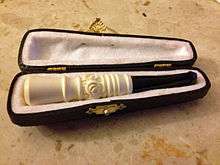Meerschaum pipe

A Meerschaum pipe is a smoking pipe made from the mineral sepiolite. Meerschaum (![]() i/ˈmɪərʃɔːm/ MEER-shawm or /ˈmɪərʃəm/ MEER-shəm, German for foam of the sea) is sometimes found floating on the Black Sea and is rather suggestive of sea-foam, hence the German origin of the name, as well as the French name for the same substance écume de mer. German pipe builder Kummer was the first to make this pipe popular. The Kummer Pfeife became really popular with French artists and painters. They pronounced the word Kummer as cum mer; it became écume de mer, which was later translated to German as Meerschaum.
i/ˈmɪərʃɔːm/ MEER-shawm or /ˈmɪərʃəm/ MEER-shəm, German for foam of the sea) is sometimes found floating on the Black Sea and is rather suggestive of sea-foam, hence the German origin of the name, as well as the French name for the same substance écume de mer. German pipe builder Kummer was the first to make this pipe popular. The Kummer Pfeife became really popular with French artists and painters. They pronounced the word Kummer as cum mer; it became écume de mer, which was later translated to German as Meerschaum.
History

The first recorded use of Meerschaum for making pipes was around 1723 and quickly became prized as the perfect material for providing a cool, dry, flavorful smoke. The porous nature of Meerschaum draws moisture and tobacco tar into the stone. Meerschaum became a premium substitute for the clay pipes of the day and remains prized to this day though, since the mid-1800s, briar pipes have become the most common pipes for smoking.
The use of briar wood beginning in the early 1820s greatly reduced demand for clay pipes and, to a lesser degree, Meerschaum pipes. The qualities of the Meerschaum were combined with those of the briar wood pipes by lining a briar pipe with a Meerschaum bowl. Some believe that the Meerschaum-lined briar pipe gives the porosity and sweet smoking qualities of meerschaum along with the heat-absorbing qualities and durability of briar.
Characteristics
When smoked, Meerschaum pipes gradually change color, and old Meerschaum pipes will turn incremental shades of yellow, orange, red, and amber from the base on up. When prepared for use as a pipe, the natural nodules are first scraped to remove the red earthy matrix, then dried, again scraped and polished with wax. The crudely shaped masses thus prepared are turned and carved, smoothed with glass-paper, heated in wax or stearine, and finally polished with bone-ash, etc.
Worldwide use
Carved Turkish Meerschaum products traditionally were made in manufacturing centers such as Vienna. Since the 1970s, though, Turkey has banned the exportation of Meerschaum nodules, trying to set up a local Meerschaum industry. The once famous manufacturers have therefore disappeared and European pipe producers turned to others sources for their pipes.
Another variation of Meerschaum pipe is the calabash pipe made iconic by William Gillette's stage portrayal of Sherlock Holmes. The calabash is a gourd similar to a squash, grown specifically for use in pipes. The shape is determined as the gourd grows by placing small blocks under the stem, forcing it into a gentle curve. The mature gourd is cut and dried, then fitted with a cork gasket to receive a Meerschaum bowl. The finished pipe offers one of the coolest, driest smokes available.
In Somalia and Djibouti, Meerschaum is used to make the dabqaad, a traditional incense burner. The mineral is mined in the district of El Buur, the latter of which serves as a center for quarrying. El Buur is also the place of origin of the local pipe-making industry.[1]
Similar materials
Imitations are made in plaster of Paris and other preparations.
The soft, white, earthy mineral from Långbanshyttan, in Värmland, Sweden, known as aphrodite (Greek: sea foam),[2] is closely related to Meerschaum. It is a synonym for the smectite clay: stevensite.[3]
Popular culture
- Referenced in Edgar Allan Poe's short story "The Purloined Letter" and in Jan Neruda's short story "How Mr. Vorel Broke in His Meerschaum".
- The character of Hamm in Samuel Beckett's one-act play Endgame talks about calmly filling his meerschaum.
- A meerschaum pipe plays a major role in "The Dick Van Dyke Show" episode, "The Meershatz Pipe".
- An intricate meerschaum pipe is a major plot device in the film National Treasure.
- A meerschaum pipe played a major role in the TV show, "Leave It To Beaver". Beaver tried to smoke coffee in his father's meerschaum pipe, and got very sick.
- Frank Serpico is known to smoke a meerschaum pipe in the book Serpico by Peter Maas.
- In the Quentin Tarantino film Inglorious Basterds (2009), the character Hans Landa is shown to smoke a Meerschaum.
- In the AMC series "Hell on Wheels", main character Cullen Bohannon smokes a Meerschaum pipe throughout season 3.
Notes
- ↑ Abdullahi, Mohamed Diriye (2001). Culture and customs of Somalia. Greenwood. pp. 98–99. ISBN 978-0-313-31333-2.
- ↑ "Tobacciana – Meerschaum Pipes". kelekchens.com. Retrieved 13 January 2013.
- ↑ Stevensite on Mindat.org
![]() This article incorporates text from a publication now in the public domain: Chisholm, Hugh, ed. (1911). "Meerschaum". Encyclopædia Britannica (11th ed.). Cambridge University Press.
This article incorporates text from a publication now in the public domain: Chisholm, Hugh, ed. (1911). "Meerschaum". Encyclopædia Britannica (11th ed.). Cambridge University Press.
